Tom's Guide Verdict
While this printer is pricey up front, the ET-2550's refillable ink tanks make it very economical over time and a good fit for people with heavy printing demands.
Pros
- +
Very low cost per page
- +
Excellent photo-print and scan quality
- +
Fast at black-and-white copying
- +
Fast to start up
Cons
- -
High up-front cost
- -
Slow scanning and photo printing
Why you can trust Tom's Guide
The Epson Expression ET-2550 EcoTank ($400, or less if you use one of our Epson coupon codes) offers one of the most enticing propositions in today's ink-jet printer market: inexpensive ink. Since this printer has four refillable ink tanks instead of replaceable ink cartridges, you buy inks by the bottle, not by the cartridge. The resulting cost per page is a fraction of what you pay with competing models. But the high up-front cost makes the deal sound a little less sweet: Models with similar features cost as little as $100.
Design
The compartment containing the four ink tanks sticks out from the right side of the unit, giving the ET-2550 a different look than that of printers using cartridges. Here, you lift a cover, revealing the four tanks, with their pop-off caps.
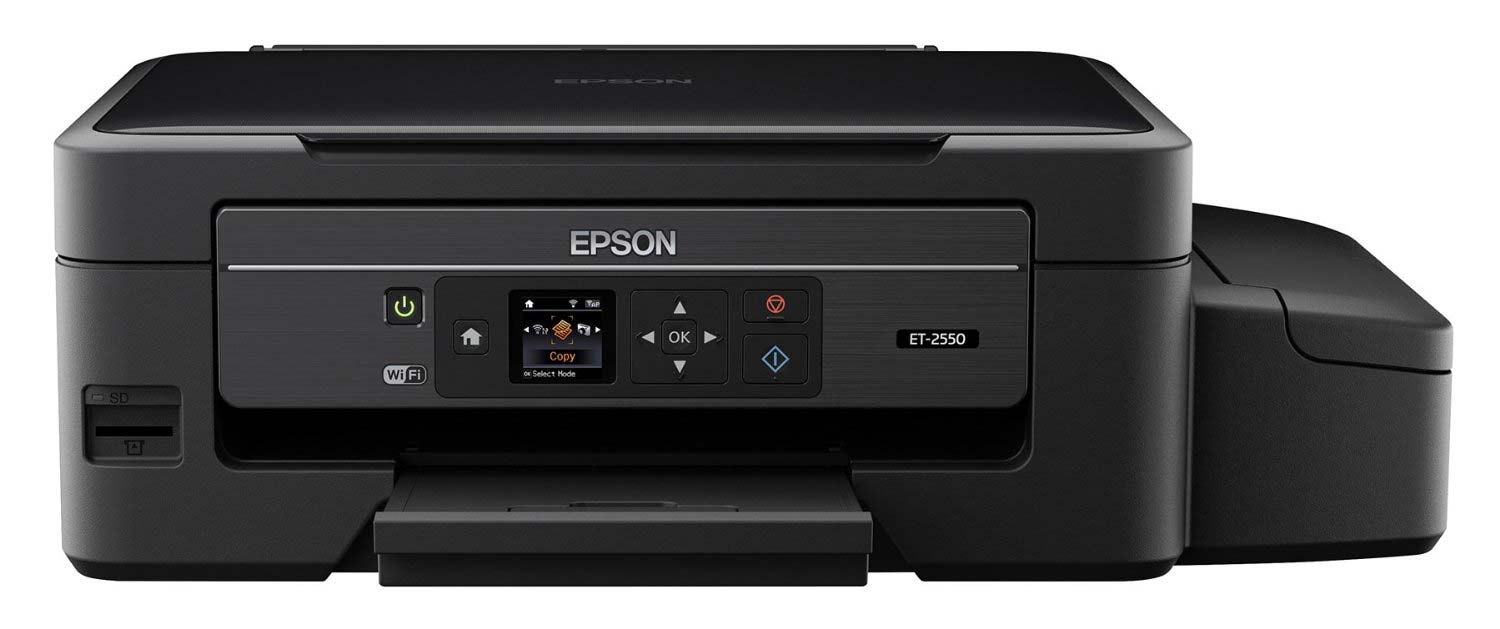
The front control panel has few buttons and a small, 1.4-inch screen, which makes stand-alone operation less than optimal, especially since it's not a touch display. When you use the control panel to initiate a scan, for example, the screen offers no settings menu for changing the resolution. You need to do that kind of adjustment on a PC.
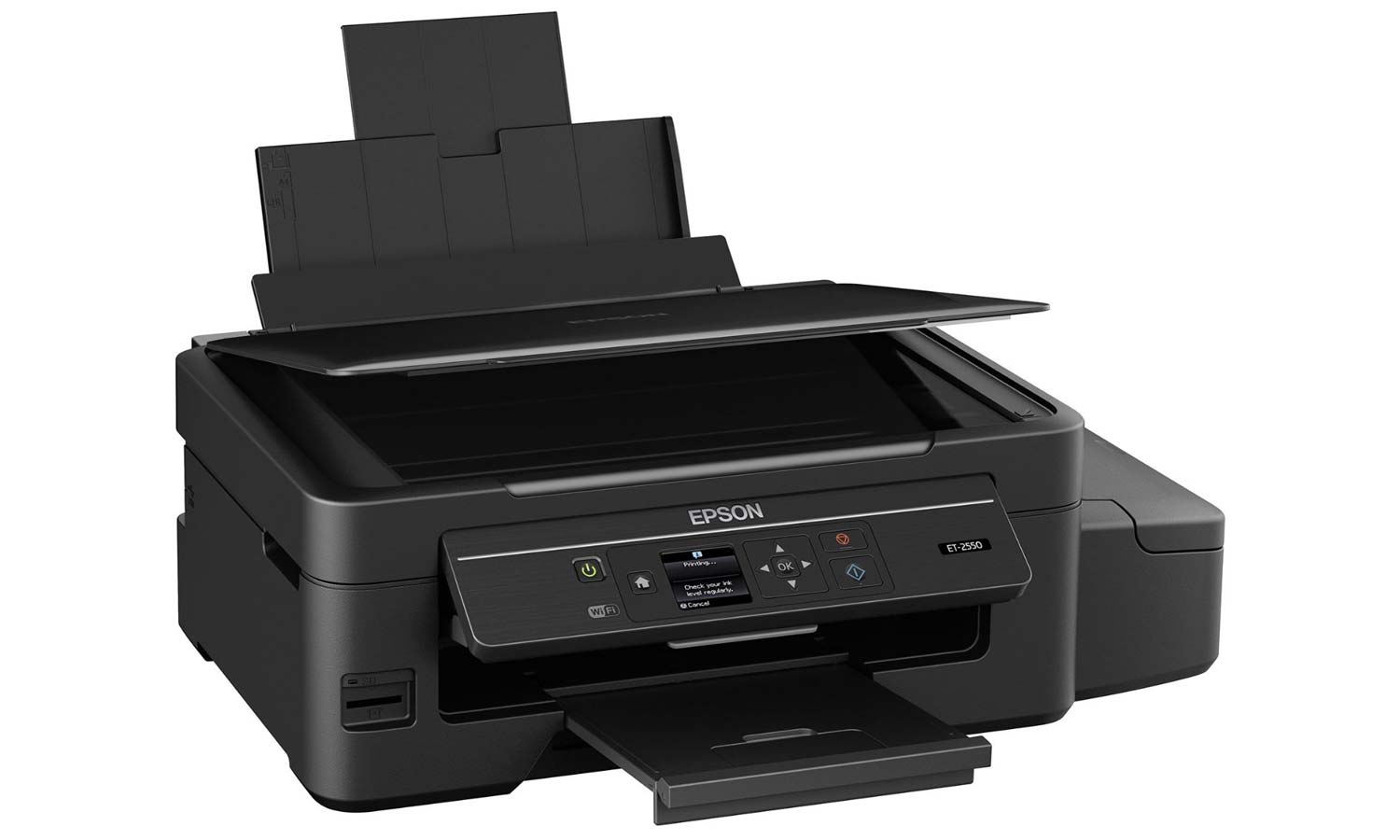
The ET-2550 prints, scans and copies, but has no fax. Its single, 100-sheet input tray sticks up from the back of the unit, and you load paper vertically. There is no dedicated secondary tray for photo paper or other specialty media, so you'll have to swap media when switching print tasks. An SD Card slot on the front panel, to the left of the output tray, conveniently lets you print from your camera’s memory card; however, you can’t scan a document to a card in the slot.
Print Speed
The ET-2550 isn't particularly fast at printing everyday documents on plain paper. It printed our five-page text document in 42 seconds, or 7.1 pages per minute (ppm). This was roughly 5 seconds slower than the HP Envy 5540. Using Quiet mode, which made a moderate reduction in the noise level, the ET-2550 printed the same document in 53 seconds.
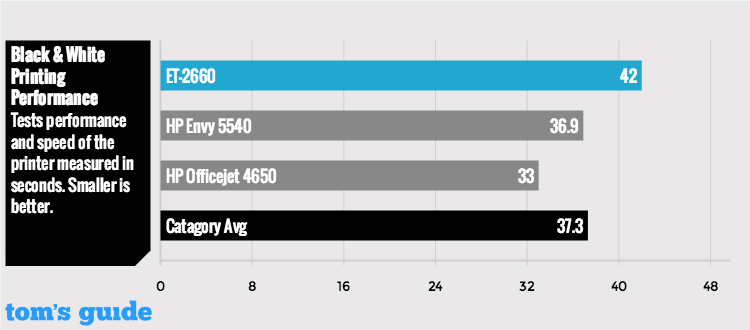
Our six-page document that mixes text and graphics arrived in 2 minutes, 56 seconds, or 2 ppm, which was middle of the road. By comparison, the HP Envy 5540 printed the same document roughly half a minute faster, while the HP OfficeJet 4650 took roughly a half a minute longer. Using Epson's iPrint app on an Android phone, a page of text and graphics printed in about half the speed of printing from a PC, taking more than a minute (1:03) to print a single page.
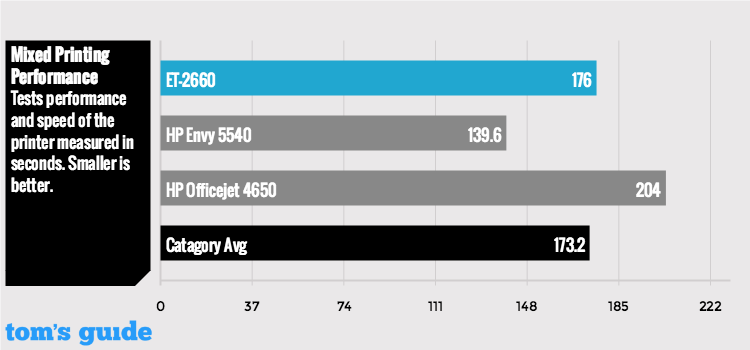
Where the ET-2550 really takes a "steady as she goes" approach is on glossy paper. A full-page color photo printed on letter-size paper took almost 6 minutes to arrive. The HP Envy 5540 printed the same photo in less than half the time.
The results were similar when printing in High-Quality mode on 4-by-6-inch photo paper: The ET-2550 printed a photo in 2:13, while the HP Envy 5540 did so twice as fast. Reducing the ET-2550's quality setting to standard quickened the pace to 1:16. The finished product wasn’t always worth the wait, as we'll discuss below.
Copy and Scan Speed
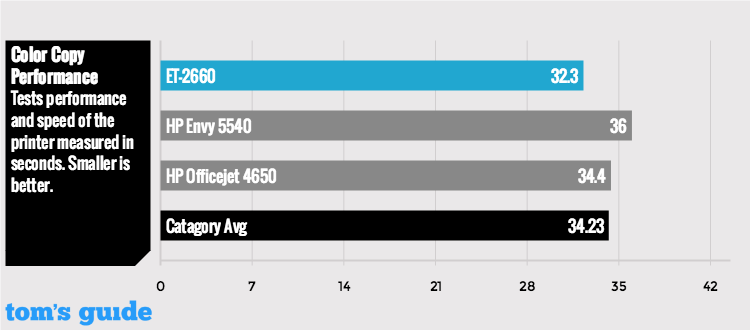
The ET-2550 produced comparatively faster black-and-white copy times versus its print performance. It made a color copy in 32.3 seconds, which was on a par with other tested ink jets.
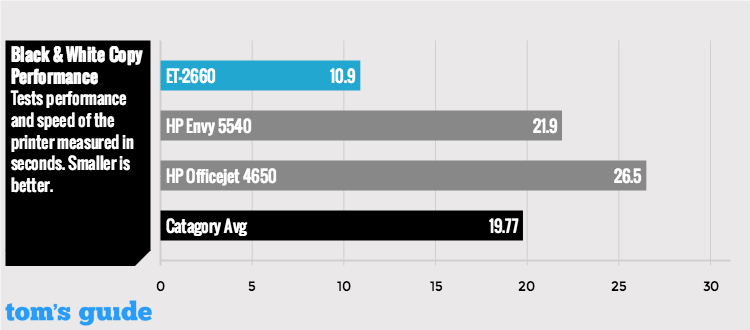
It was most impressive in making black-and-white copies, spitting these out in 10.9 seconds, more than twice as fast as the office-oriented HP OfficeJet 4650. To make copies even more quickly on the ET-2550, you can use its draft mode; one page of draft text arrived in 7.3 seconds, though the quality was subpar.
Scanning a color photo at 600 dpi to JPEG format took almost 2 minutes (1:57), which was 15 seconds slower than on the HP Envy 5540. These times include a preview scan. Scanning will go much more quickly if you don't need a very high resolution. Scanning at 300 dpi took 43 seconds in color and 22 seconds at 300 dpi in black and white.
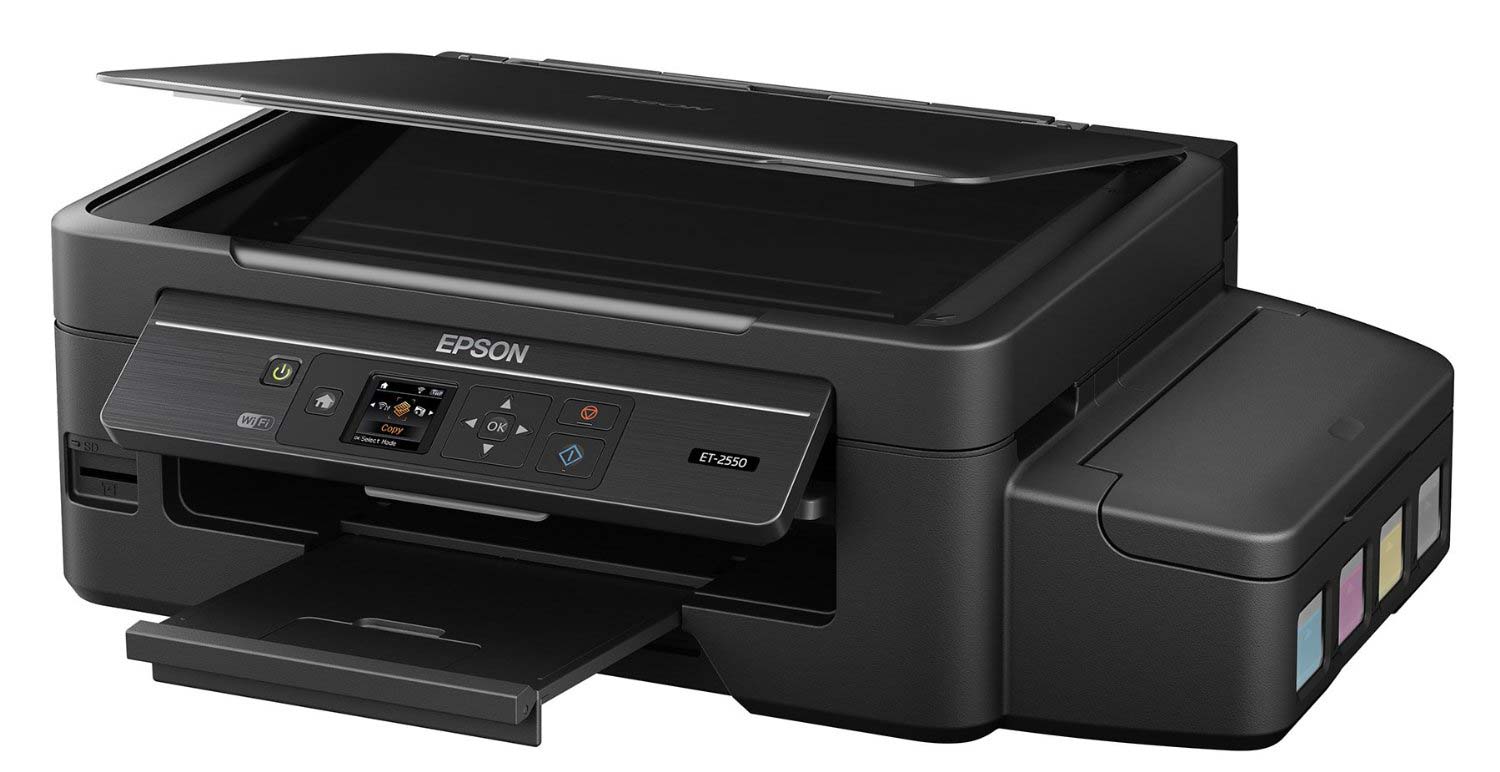
The ET-2550 scanned a document at 300 dpi to a black-and-white PDF in 38.3 seconds, almost four times longer than the HP Envy 5540. This included a preview scan of 10 to 15 seconds, which the HP Envy 5540 did not perform in this mode.
Print Quality
The ET-2550 produces very detailed photos with "pop" that should please discerning photographers. But compared to the HP Envy 5540, which also produces very high-quality photo glossies, the difference is subtle, and the devil is in the very fine details.
The ET-2550 produces very detailed photos with 'pop' that should please discerning photographers.
The ET-2550 created prints with deeper dark shades; very fine details looked a little sharper upon close examination. And where the Envy 5540's prints had a slightly cloudy cast, the ET-2550's looked clearer, with a little more depth.
The quality of printed text isn't quite as impressive with the ET-2550. Letter forms were not as strong a black as those printed by the Envy 5540, and the edges not quite as sharp. That said, neither printer neared the razor-sharp text you'd expect from a laser printer. Both models made equally attractive prints of color graphics on plain paper.
MORE: Best All-in-One Printers
Copy quality left a little to be desired. By comparison, the Envy reproduced colors in richer tones, and retained sharper details in its copies. Scans of photographs looked very sharp, with accurate color and plenty of detail.
Ink/Toner Cost and Yield
Most printers offer low up-front prices, with the costs of replacing ink adding up over time. It's quite the opposite with the ET-2550, which has a high initial price tag of $400, but offers affordable ink in refill bottles. So how long will it take for you to save what you spent up front? Let's do some quick back-of-the-napkin math to make a comparison to the $100 HP Envy 5540, using the page-yield specifications from Epson and HP.
First, let's assume you print a lot, and that every page is a color page with equal coverage of 5 percent per color (the ISO standard). At 500 pages a month (the recommended monthly page volume for the ET-2550), it would take almost five months to save the $300 extra you paid versus the Envy 5540.
Despite the cost per page, the difference in purchase price means it will take quite a few prints before you recoup your investment in the ET-2550.
For this quick calculation, I assumed use of high-yield cartridges in the Envy 5540, though I didn't include HP's ink-subscription program, which offers additional savings. Costs per color page using these specifications are 15.6 cents for the Envy 5540 and less than a cent (0.93 cents to be precise) for the ET-2550. To save $300, you'd need to print more than 2,000 pages. Cost per black-and-white page for the ET-2550 is just 0.3 cents versus 6 cents for the Envy 5540. If you printed 500 text pages a month, it would take 5,291 pages, or 10 and a half months, to recoup that $300. So, despite the dramatic difference in cost per page, the similarly dramatic difference in purchase price means it will take quite a few prints before you recoup your investment in the ET-2550.
Setup
If you've never filled an ink tank before, you're likely wondering how messy the process is. I found it simple to open the ink bottles and pour the ink into the ET-2550's reservoirs without unintentionally making a Jackson Pollock painting on my desk. I only got a few tiny drops of ink on my fingers in the process.
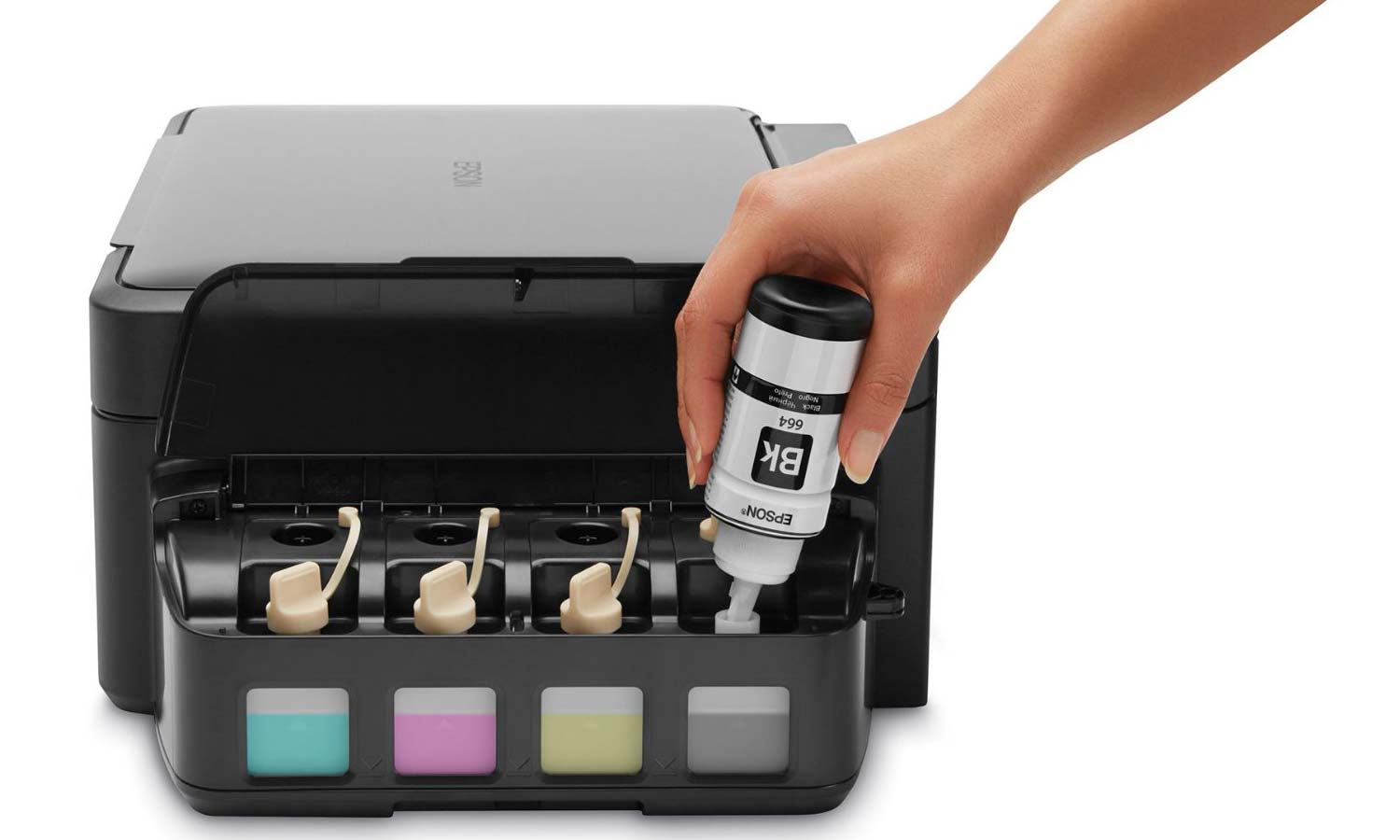
Setting up the ET-2550 on my network was easy. The menus offer a WPS mode, in which pressing a button on my wireless router added the printer to my network.
Startup Time
The ET-2550 is fast to start up. The home screen on LCD appeared at 6 seconds, which was significantly faster than on the Envy 5540, which took almost 12 seconds. The ET-2550 kicked out its first copy at 18.7 seconds.
Software
The ET-2250 comes with a basic software suite for printing, scanning and copying. The Epson Connect program allows you to print and scan remotely, including a scan-to-cloud function and an email-print function that lets you send an email to the printer's unique email address to automatically print the file. Using the iPrint app, you can print from an Android or iOS mobile device. However, at least on an Android device, you will need to open your intended document via the app: The Epson ET-2550 does not show up in the printers list if you open a document in its native application and attempt to print from there.
MORE: Best Photo Book - Photography Book Printing Services
The software print driver warns against operating the printer when the amount of ink falls below a line on the ink tanks, since that could damage the printer. The printer's LCD issues a similar warning, repeatedly, to check ink levels. Epson says that without damage, the permanent print head is expected to last the life of the printer.
Bottom Line
The ET-2550 offers a dramatic reduction in ink costs and produces excellent photo prints and scans. Serious photographers will love the sharpness and depth of the ET-2550's glossy photo prints — and given their heavy use of ink, stand to benefit the most from this model's unique, refillable ink tanks. Photo print times are slow, however. And although the ET-2550 makes black-and-white copies quickly, its middle-of-the-road text and copy quality limit this printer's versatility.
Eric Butterfield is a freelance writer and musician from California. His work has appeared in PC World magazine, CNET, Taproot, and Alter Action — plus Tom's Guide, of course — while his music has appeared in more than 260 TV show episodes for major networks such as NBC, Hulu, BBC America, and more. You can check out his work on Spotify.
